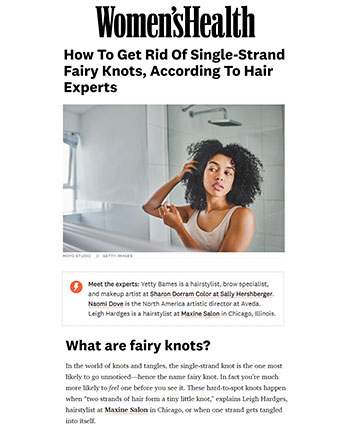Women's Health July 8, 2024
 Women's Health
Women's Health
Beauty
How To Get Rid Of Single-Strand Fairy Knots, According To Hair Experts
Believe it or not, there are ways to prevent them.
Fairy knots: Sounds like one of 2024's biggest hair trends, right? Not so much—and those who know the truth understand they're as pesky and mischievous as their namesake. “Also known as single-strand knots, fairy knots are medically known as trichonodosis and are small tangles or knots that form around the mid-shaft of the hair,” says Yetty Bames, hairstylist, brow specialist, and makeup artist at Sharon Dorram Color at Sally Hershberger.
Meet the experts: Yetty Bames is a hairstylist, brow specialist, and makeup artist at Sharon Dorram Color at Sally Hershberger. Naomi Dove is the North America artistic director at Aveda. Leigh Hardges is a hairstylist at Maxine Salon in Chicago, Illinois.
As someone with curly natural hair, tackling single-strand knots is easily one of my top three hair frustrations. Most times these tiny knots seem to crop up out of nowhere, and detangling something that small is a major feat, requiring a level of patience I don’t have.
Yet while they seem to show up like magic, there are many reasons why you might develop fairy knots. “Simple neglect, frequent sleek ponytails, accessories that cause hair to be stretched unnaturally, and not having a consistent routine are all reasons why someone might start developing single-strand knots," according to Naomi Dove, an artistic director at Aveda.
Although single-strand knots are a nuisance, there are a few ways to manage and prevent them on your own before they get out of hand. Here's everything you should know about warding them off for good.
What are fairy knots?
In the world of knots and tangles, the single-strand knot is the one most likely to go unnoticed—hence the name fairy knot. In fact you’re much more likely to feel one before you see it. These hard-to-spot knots happen when “two strands of hair form a tiny little knot," explains Leigh Hardges, hairstylist at Maxine Salon in Chicago, or when one strand gets tangled into itself.
What causes fairy knots?
While single-strand knots can be a sign of split or unhealthy ends, that isn’t always the case. These knots can be caused by a few different factors and can crop up because of things beyond your control like how your hair grows or even shedding according to Bames. They can even be caused by over styling and improper detangling. However, sometimes hair type can play a role with curly and coily hair being more prone.
“The hair strand can grow in different directions, with curly or coily hair causing it to loop onto itself causing knots,” Dove says. “If hair is uncared for, the issue may worsen and at times cause other hairs to tangle with it excessively.” Hardges adds, “Because curly and coily hair is typically more porous, the lifted cuticle makes it easier for hairs to catch on to one another to form these knots.”
How to detangle fairy knots
When it comes to managing single-strand knots, the good news is that it is possible to work them loose. The bad news? It’s not always the easiest task and can pose some minor risks. According to Bames, “Single strand knots can be detangled carefully with deep conditioners, oils, massaging, and soft brushing” which can help to manipulate the knot loose. However, Dove points out that it can be difficult to detangle a knot on just one strand of hair “without causing breakage, weakening the strand, or [further] tangling.”
Should you cut fairy knots?
Cutting off single-strand knots is an excellent way to get rid of them, especially if you don’t want to attempt detangling. “The hair strands are so fine that removing them any other way could potentially cause stress and frustration,” Dove says. While cutting a rogue fairy knot every once in a while is fine, if you notice many single-strand knots showing up in your hair, Dove recommends consulting with a professional hair stylist. “An untrained person attempting to cut their own hair is not advised for aesthetic and precision purposes.”
How to prevent fairy knots
While there are a few ways to minimize the occurrence of fairy knots, Hardges notes that the best way to prevent them is to keep up with routine trims. But for hair types that are usually more prone to single-strand knots she recommends oiling the ends of your hair because they are the oldest and most damaged parts—and therefore more susceptible to tangling. “Using an oil to provide lubrication to dry hair at the ends prevents knots from forming as frequently,” she says. “My favorite daily oil is HASK Argan Oil because it both hydrates and reduces frizz.”
For Bames, along with keeping hair moisturized and detangled she recommends wearing “styles that don’t encourage knotting” (think easy looks that don't put too much tension on hair). Dove, meanwhile, is a proponent of having a good cleansing, conditioning and prep routine which includes “alternating between shampooing and co-washing, and ensuring masking occurs at least once a month.”
In addition, sleeping with a satin bonnet or on a silk pillowcase is great for avoiding friction.
